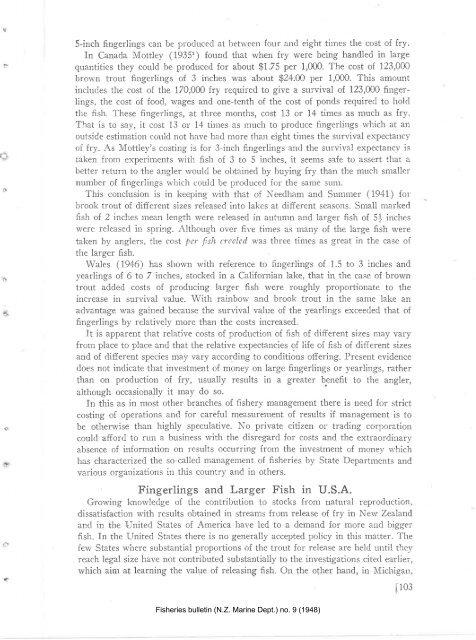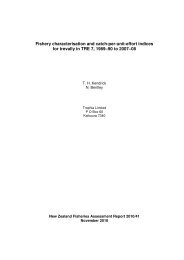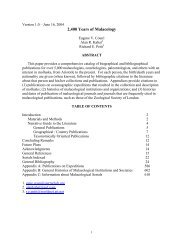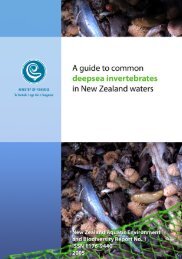N.Z. MARINE DEPARTMENT-FISHERIE,S BULLETIN No. .į
N.Z. MARINE DEPARTMENT-FISHERIE,S BULLETIN No. .į
N.Z. MARINE DEPARTMENT-FISHERIE,S BULLETIN No. .į
You also want an ePaper? Increase the reach of your titles
YUMPU automatically turns print PDFs into web optimized ePapers that Google loves.
S-inch fingerlings can be pr:oducecl at betrveen four ancl eight titires the cost of fry.<br />
In Canada Nîottley (1935') fotrnd that when fry were being handled in large<br />
quantities they could be produced for about .$1.75 per 1,000. The cost of 123,000<br />
brown trout fingerlings of 3 inches was about $24.00 per 1,000. This amount<br />
includes tl-re cost of the 170,000 fry required to give a survival of 123,000 fingerlings,<br />
the cost of foocl, wages and one-tenth of the cost of ponds required to holcl<br />
tlie fish. These fingerlings, at thre:e months, cost 13 or 14 times as much as fry.<br />
That is to say, it cost 13 or 14 tirnes as much to produce fingerlings rvhich at an<br />
or-rtside estimation could not have had more than eight times the survival expectancy<br />
of fry. As Mottley's costing is for 3-inch fingerlir-igs elrcl the survival expectancv is<br />
taken from experiments with fish of 3 to 5 inches, it seerns safe to assert that a<br />
better return to-the angler rvould be obtained by buying fry than the much smallelntrmber<br />
of fingerlings rvtrich could be produced for the salne sll1l.<br />
This conclusion is in keeping r,r,ith that of l{eedharn and Sutlrner (1941) for'<br />
brook trout of difierent sizes leleasiecl into lakes at clifferent seaso11s. Small marked<br />
fish of 2 inches mean length were released in autumn and larger fish of 5f-inches<br />
were releasecl in spring. Although over fir'e times as many o{ the large fish were<br />
taken by anglers, tl.re cost þer fslt, creeled was tl¡ree times as great in the case of<br />
the larger fish.<br />
Wales (1946) has shown with reference to fingerlings of 1.5 to 3 inches ancl<br />
yearlings of 6 to 7 inches, stocked in a Californian lake, that in the case of brown<br />
trout added costs of producing larger fish were roughly proportionate to the<br />
increase in survival value. \Mith rainbor,v ancl brook trout in the same lake an<br />
advantage was gained because the survival value of the year'lings exceeded that of<br />
fingerlings by relatively more than the costs increased.<br />
It is apparent that relative costs of production of fish of different sizes rnay vary<br />
from place to place and that the relative expectancies of life of fish of different sizes<br />
ancl of clifferent species may vary according to conditiåns offering. Present evidence<br />
does not indicate that investmsnf ç'f money on large fingerlings or yearlings, rather<br />
than on production of fry, usually results in a greater benefit to the angler,<br />
although occasionally it may do so.<br />
In this as in most other branches of fishery management there is need for strict<br />
costing of operations ancl for careful lreasurement of results if management is to<br />
be otherwise than highly speculative. ltro private citizen or- trading corporation<br />
could afford to run a business r'vith the disregard for costs and the extraordinary<br />
absence of inforrnation on results occurring {rom the investment of money r'r'hich<br />
has characterizecl the so-called management of fisheries by State Departrnents and<br />
various organizations in this collntry and in others.<br />
Fingerlings and Larger Fish in U.S.A.<br />
Grorving know'ledge of the contribution to stocks from natural reproduction,<br />
clissatisfaction with results obtained in streams frotn release of fry in New Zealand<br />
and in the lJnited States of America have led to a demand for more ancl bigger'<br />
frsh. In the United States there is no generally accepted policy in this matter. Tl-re<br />
few States r,vhere substantial proportions of the trr.¡ut for release are helcl until they<br />
reach legal size have not contributed substantially to the investigations citecl earlier,<br />
which aim at learning the value of releasing fish. On the other hand, in Micl-rigan,<br />
Fisheries bulletin (N.Z. Marine Dept.) no. 9 (1948)<br />
I 103







